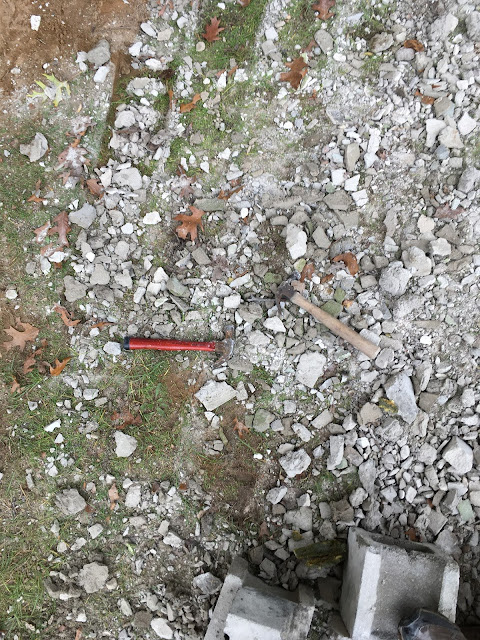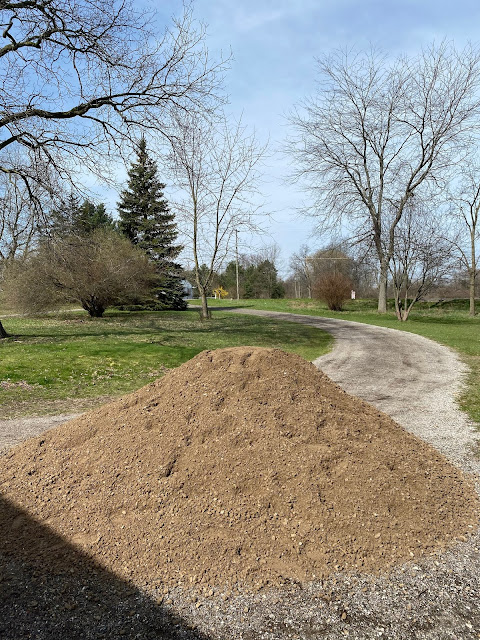Mid July. Now that the walls were up, it was time to reconstruct the trusses. The trusses were made with true 2x6 beams nailed to true 2x4 top chords, with no webbing in between. The wood is super dense and heavy, just like the walls. When we took them down, they had to be separated for transport, cutting through the nails with a reciprocating saw, so before they were removed, we labeled each piece with a number for reassembly.
I started by putting each beam up, as lifting an entire truss was just not possible. Because of where there used to be windows along the front wall, the spacing was not 24" on center all the way across, so I just did the same with the beams to keep them on the vertical studs.
I could do the beams myself, lifting them up on one end, getting the ladder to the other and lifting into place, and then toenailing into the headers, but the trusses were just too big and awkward to lift into place. So until I could get some help, I worked on filling in the siding.
On a traditional barn, when they have boards on the gable wall, they don't bother adding anything to the wall to make the boards overlap the bottom wall covering, but I wanted mine to actually remain straight up and down, so I added 3/4" of material across the top of the extension wall so that when I nailed in the extension siding, it was straight up and down.
Within a couple of days, Matt was able to come over and help me lift the trusses into place. I measured the distance at the bottom of the truss pieces to make sure they were at the right angle at the top, nailed them together and added mending plates for extra security.
We weren't able to do them all at once, so over the next week I had both Becky and Trevor helping as well, and soon we had all of them up.
You'll see a cross piece in above, and that's after making sure each was vertically level, we added a 1x4 to keep them in place so that when we did the roof sheeting they were straight up and down. In some cases, that required some motivation in the form of a ratchet strap.
I fixed one end of the strap to the outside wall, and then tied it around the truss and cranked it down till it was upright, and then screwed in the 1x4 cross piece to hold it in place.
With the main trusses in place, it was time to build the back additions and monopitch roof to match the shed's back section. This is practically the only part of this project I bought new materials for that aren't fasteners. The walls are just standard 2x4 and the joists are 2x6, everything 16" on center. I notched the 2x6's out to rest on the cross beam so that they would match the height of the shed's back section roof so I'd end up with one flat platform all the way across. Initially I thought I'd make them lower than the middle, to just make them match the height of the beam, but after consulting with my roofer, it seemed like just another leak point to have two different heights, so I did the work to make those joist notches.
With all the framing completed, I bought all the roof decking and started putting that up. I knew I'd need help from Kole (roofer) to tie into the shed, and to put decking on the side where there was nothing to stand on, so I just did what I could to start.
By the end of the next day, Kole had tied into the existing roof (myself being ECSTATIC that the roof line of the barn parts was almost exactly the height of the shed, and therefore my calculations weren't way off) and we'd sheeted the whole thing.
Next day he came back and dried it in with ice & water shield and underlayment to protect it till they could get the shingles ordered and delivered.
While I waited for the shingles to come in, I capped the ends of the barn with exterior plywood and 1x2 strips.
To keep sealing things in, I also started putting up the old metal roof as siding on the iso room. Since I was doing spray foam, I didn't bother putting wood under the metal roof, I just made sure all the holes were covered with duct tape (the kids helped!) and that everything was nailed in tight.
At first I was going to leave the old wood panels on the control room, but seeing how cool this looked with the metal, I decided to keep it going all the way across.
I was also agonizing over what to do with the walls of the lounge. Seeing it open at the back had me really wanting to put windows in. I had a couple crappy windows I picked up from the side of the road, but they turned out to be pretty broken. I also wanted to put the door on that side, but it would end up a little below grade, which is never good.
As luck would have it, I saw an ad for (6) 6' tall double pane windows in wood frames for $120. That's $20 a window. Unbelievable. I messaged the woman and she said they were at a garage sale, so I booked it over to Wyoming and she gave them all to me for $100.
I got them home, reframed my back corner, and decided the door would be in the control room and off the back instead of the side. The height of the windows was exactly the height of the wall minus 1.5", which is (you guessed it) exactly a 2x4.
Knocking the back wall out I added the rest of the metal and added the door frame from a 36" steel door I'd purchased from Craigslist.
I swapped the steel door with a super heavy wood door from the 60's I'd also found on CL, and the back was nearly done.
At that time, the shingles showed up, so Kole and Taylor came back to finish that job. To marvelous results
No one will ever notice when in the space, but because the last stud on the barn wall had a bit of a lean to it, so did the wall I built off of it, and therefore the back wall kind of angles out from the control room to the corner. It was fine in the end, but always check your levels, ladies & gentlemen, lest you end up with this same problem.
Next time - insulation, plus all my interior wall woes.




























































